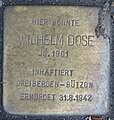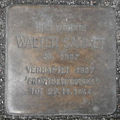Category:Stolpersteine for homosexuals
Jump to navigation
Jump to search
English: Shown on this page are Stolpersteine for homosexual victims of the Nazi era. In 2015, a Stolperstein was set in place at Singerstraße 120, Berlin, for Elli Smula, a lesbian victim of the Nazi era.
Stolperstein is the German word for "stumbling block", "obstacle", or "something in the way". Starting in 1997, the artist Gunter Demnig gave this word a new meaning, that of a small, cobblestone-sized memorial for a single victim of Nazism set in the pavement before the building in which this person lived or worked. The list of locales that have Stolpersteine now extends to several countries and over 1,100 cities and towns in Germany.
| NO WIKIDATA ID FOUND! Search for Stolpersteine for homosexuals on Wikidata | |
| Upload media |
Subcategories
This category has the following 2 subcategories, out of 2 total.
Media in category "Stolpersteine for homosexuals"
The following 112 files are in this category, out of 112 total.
-
2021 Stolperstein Alfred Zoeller - by 2eight - ZSC1808.jpg 2,048 × 2,048; 2.78 MB
-
Arnold Bastian.jpg 2,560 × 1,920; 1.76 MB
-
Arthur Wese.jpg 1,920 × 2,560; 1.69 MB
-
August Niemann.jpg 1,920 × 2,560; 1.97 MB
-
Willi Bröckler - Humboldtstraße 122 (Hamburg-Barmbek-Süd).Stolperstein.nnw.jpg 2,316 × 2,316; 2.53 MB
-
Erich Mäder-Stolperstein.jpg 2,685 × 2,025; 5.23 MB
-
Ernst Schünemann.jpg 594 × 590; 64 KB
-
Erwin Rümmele-Stolperstein.jpg 2,733 × 2,050; 5.15 MB
-
Flörsheim am Main Stolperstein Hochheimer Straße 4 Jakob Altmaier.jpg 1,500 × 1,434; 1.8 MB
-
Fritz Hauser-Stolperstein.jpg 3,120 × 2,364; 7.48 MB
-
Gustav Schreiber.jpg 2,560 × 1,920; 2.41 MB
-
Wilhelm Jastram - Vogteiweg 6 (Hamburg-Barmbek-Süd).Stolperstein.nnw.jpg 2,226 × 2,226; 3.01 MB
-
Paul Lucht - Mozartstraße 4 (Hamburg-Barmbek-Süd).Stolperstein.nnw.jpg 2,193 × 2,193; 2.13 MB
-
Stolperstein Lübecker Straße 101 (Robert Behr) in Hamburg-Hohenfelde.JPG 2,346 × 2,410; 3.23 MB
-
Stolperstein Lübecker Straße 72 (Wilhelm Dose) in Hamburg-Hohenfelde.JPG 2,352 × 2,472; 3.24 MB
-
Stolperstein Breitenfelder Straße 1 (Günther Frühling) in Hamburg-Hoheluft-Ost.JPG 2,556 × 2,574; 4.06 MB
-
Stolperstein Eppendorfer Landstraße 132 (Friedrich Gevert) in Hamburg-Eppendorf.JPG 2,766 × 2,886; 4.8 MB
-
Jasper Holtmann - Suhrenkamp 98 (Hamburg-Ohlsdorf).Stolperstein.ajb.jpg 2,329 × 1,747; 3.92 MB
-
Jasper Holtmann - Suhrenkamp 98 (Hamburg-Ohlsdorf).Stolperstein.crop.ajb.jpg 1,080 × 1,080; 897 KB
-
Stolperstein Lehmweg 31 (Walter Klahn) in Hamburg-Hoheluft-Ost.JPG 2,016 × 2,064; 2.59 MB
-
Stolperstein Haynstraße 25 (Hans-Joachim Kubel) in Hamburg-Eppendorf.JPG 2,016 × 2,022; 2.23 MB
-
Stolperstein Woldsenweg 7 (Otto Luria) in Hamburg-Eppendorf.JPG 2,478 × 2,598; 3.71 MB
-
Hubert Mayer - Mühlendamm 12 (Hamburg-Hohenfelde).Stolperstein.ajb.jpg 2,483 × 1,862; 3.92 MB
-
Friedrich Meier - Framheinstraße 4 (Hamburg-Barmbek-Süd).Stolperstein.nnw.jpg 2,496 × 2,496; 2.48 MB
-
Rudolf Müller - Diesterwegstraße 4 (Hamburg-Barmbek-Nord).Stolperstein.nnw.jpg 2,550 × 2,550; 2.73 MB
-
Heinrich Orgler - Hufnertwiete 2 (Hamburg-Barmbek-Nord).Stolperstein.nnw.jpg 2,403 × 2,403; 2.19 MB
-
Stolperstein Geibelstraße 61 (Karl Peters) in Hamburg-Winterhude.JPG 2,000 × 2,052; 2.88 MB
-
Stolperstein Woldsenweg 5 (Georg Peters) in Hamburg-Eppendorf.JPG 2,340 × 2,334; 3.02 MB
-
Stolperstein Lübecker Straße 72 (Woldemar Preussner) in Hamburg-Hohenfelde.JPG 2,844 × 2,898; 4.75 MB
-
Stolpersteine Hamburg – Robert Rönnau.JPG 3,296 × 3,312; 7.07 MB
-
Bruno Schulz - Ilenbrook 14 (Hamburg-Wilhelmsburg).Stolperstein.nnw.jpg 2,379 × 2,379; 2.23 MB
-
Stolperstein Heider Straße 6 (Erich Starke) in Hamburg-Hoheluft-Ost.JPG 2,400 × 2,400; 3.45 MB
-
Hermann Strübing - Barmbeker Straße 177 (Hamburg-Winterhude).Stolperstein.ajb.jpg 2,416 × 1,812; 4.05 MB
-
Stolperstein Hamburg Innenstadt.jpg 1,024 × 643; 422 KB
-
Stolperstein Eppendorfer Weg 258 (Ernst Wassermann) in Hamburg-Hoheluft-Ost.JPG 2,706 × 2,706; 4.04 MB
-
Stolperstein Eppendorfer Weg 258 (Hans Wassermann) in Hamburg-Hoheluft-Ost.JPG 2,772 × 2,862; 4.71 MB
-
Kurt Wilcke - Mildestieg 27 (Hamburg-Barmbek-Nord).Stolperstein.nnw.jpg 2,379 × 2,379; 2.35 MB
-
Theodor Wulff - Oertzweg 15a (Hamburg-Barmbek-Nord).Stolperstein.nnw.jpg 2,370 × 2,370; 2.45 MB
-
Hans Winterhalter-Stolperstein.jpg 2,950 × 2,278; 5.67 MB
-
Herbert Kenneweg.jpg 814 × 584; 62 KB
-
HH Stolperstein Otto Aron.jpg 1,240 × 1,240; 259 KB
-
Kurt Rampoldt.jpg 536 × 556; 88 KB
-
Stolperstein - Friedrich H. Enchelmeyer.jpg 2,560 × 1,920; 2.36 MB
-
Stolperstein - Willi Karl App.jpg 1,143 × 996; 266 KB
-
Stolperstein Binderstraße 13 (Hans Meyer) in Hamburg-Rotherbaum.JPG 2,176 × 2,164; 2.56 MB
-
Stolperstein Emmentaler Str 74 (Reind) Herbert Gürtzig.jpg 2,879 × 2,907; 6.36 MB
-
Stolperstein Flensburg Bastian.jpg 2,048 × 1,536; 2.32 MB
-
Stolperstein für Gerhard Möller.jpg 6,000 × 4,000; 9.07 MB
-
Stolperstein für Johann Boltz.jpg 2,592 × 1,944; 505 KB
-
Stolperstein für Willi Bondi.JPG 2,845 × 2,797; 2.35 MB
-
Stolperstein Hennigsdorfer Str 17 (Heils) Herbert Schmeisser.jpg 2,896 × 2,936; 5.61 MB
-
Stolperstein in Hannover für Heinrich Hoffmann.jpg 950 × 895; 914 KB
-
Stolperstein Jahnstr 2 (Kreuz) Otto Peltzer.jpg 2,815 × 2,807; 3.46 MB
-
Stolperstein Jakob Kahn, 1, Allerheiligenstraße 26, Innenstadt, Frankfurt am Main.jpg 3,456 × 2,592; 4.98 MB
-
Stolperstein Johannes Böhme.jpg 4,000 × 3,000; 4.74 MB
-
Stolperstein Krautstr 29 (Frhai) Karl Jakobs.jpg 2,796 × 2,826; 5.38 MB
-
Stolperstein Köln Alarichstraße 81 Josef Förster.jpg 1,579 × 1,501; 1.34 MB
-
Stolperstein Köln Jakordenstraße 24 Paul Wiss.jpg 1,431 × 1,414; 1.37 MB
-
Stolperstein Köln Weißenburgstraße 40 Leo Nadolny.jpg 1,396 × 1,449; 1.39 MB
-
Stolperstein Köln, Edmund Wissmann (Breite Straße 79).jpg 2,736 × 2,773; 1.69 MB
-
Stolperstein Köln, Ernst Sander (Kleiner Griechenmarkt 8).jpg 2,370 × 2,358; 924 KB
-
Stolperstein Köln, Hubert Neu (Alexianerstraße 12).jpg 2,701 × 2,741; 1.17 MB
-
Stolperstein Köln, Josef Litterscheid (St.-Apern-Str. 14-18).jpg 3,186 × 3,174; 2.36 MB
-
Stolperstein Köln, Verlegestelle (St.-Apern-Str. 14-18).jpg 4,362 × 3,601; 5.75 MB
-
Stolperstein Köln, Wilhelm Zimek (Alte Wallgasse).jpg 2,367 × 2,398; 1.47 MB
-
Stolperstein Leibnizstr 86 (Charl) Georg Schulz.jpg 2,508 × 2,478; 7.97 MB
-
Stolperstein Ludwigshafen 027 2023 06 22.jpg 3,131 × 3,131; 4.28 MB
-
Stolperstein Meißnerstraße 17 in Hamburg-Eimsbüttel.JPG 2,060 × 2,072; 1.48 MB
-
Stolperstein Neustädter Straße 31 (Hoffmann) in Hamburg-Neustadt.JPG 1,484 × 1,536; 679 KB
-
Stolperstein Neustädter Straße 31 (Jensen) in Hamburg-Neustadt.JPG 1,572 × 1,602; 784 KB
-
Stolperstein Prinzenstr 97 (Kreuz) Michael Walter.jpg 2,880 × 3,037; 6.1 MB
-
Stolperstein Schmiedestraße (Mayer Plonski) in Hamburg-Altstadt.JPG 862 × 862; 626 KB
-
Stolperstein Stargarder Str 66 (Prenz) Paul Otto Hamme.jpg 2,196 × 2,106; 2.08 MB
-
Stolperstein Striewitzweg 26 (Teltow) Reinhold Böttcher.jpg 2,292 × 2,248; 1.69 MB
-
Stolperstein Vereinsstraße 39 in Hamburg-Eimsbüttel.JPG 2,660 × 2,644; 2.68 MB
-
Stolperstein Viktor Hugo Forstmann Ludwigshafen 001 2023 06 22.jpg 3,052 × 3,052; 3.59 MB
-
Stolperstein von Friedrich Paul von Groszheim.jpg 4,563 × 3,042; 10.72 MB
-
Stolperstein Wandsbeker Marktstraße 57 in Hamburg-Wandsbek.JPG 1,983 × 1,971; 458 KB
-
Stolperstein Wexstraße 29 in Hamburg-Neustadt.JPG 1,386 × 1,428; 603 KB
-
Stolperstein Wilfrid Israel.jpg 757 × 757; 61 KB
-
Stolperstein Würzburg Obermayer Dr. Leopold.jpeg 1,321 × 1,335; 164 KB
-
Stolperstein.Kreuzberg.Prinzenstraße 97.Michael Walter.3517.jpg 1,800 × 1,800; 1.2 MB
-
Stolperstein.Mitte.Singerstraße 1.Elli Smula.5836.jpg 1,800 × 1,800; 1.1 MB
-
Stolpersteine Annenstraße 4 in Hamburg-St. Pauli.JPG 1,014 × 1,017; 142 KB
-
Stolpersteine Dortmund Kurfürstenstr. 32 StefanSchminghoff.jpg 1,360 × 1,380; 549 KB
-
Stolpersteine Dortmund Kurfürstenstr. 32.jpg 4,896 × 3,672; 5.92 MB
-
Stolpersteine Köln Kurfürstenstrasse 9 Anton Schlegel.jpg 1,796 × 1,750; 3.18 MB
-
Stolpersteine Köln Kurfürstenstrasse 9 Verlegestelle.jpg 3,000 × 4,000; 9.36 MB
-
Stolpersteine Köln, Franz Keltenich (Blaubach 69).jpg 3,262 × 3,231; 3.33 MB
-
Stolpersteine Köln, Heinrich Steiger (Schnurgasse 42).jpg 3,245 × 3,134; 4.14 MB
-
Stolpersteine Köln, Hubert Neu (Alexianerstraße 12).jpg 2,701 × 2,756; 2.51 MB
-
Stolpersteine Köln, Johann Baptist 'Tilla' Welsch (Schnurgasse 64).jpg 3,145 × 3,150; 3.56 MB
-
Stolpersteine Köln, Johann Josef Mombour (Michaelstraße 2a).jpg 3,214 × 3,223; 4 MB
-
Stolpersteine Köln, Karl Hager (Schnurgasse 12).jpg 3,114 × 3,174; 4.89 MB
-
Stolpersteine Köln, Max Kahn (Rathenauplatz 9).jpg 3,412 × 3,361; 4.2 MB
-
Stolpersteine Köln, Verlegeort Schnurgasse 2 (1).jpg 3,648 × 4,864; 7.51 MB
-
Stolpersteine Köln, Verlegeort Schnurgasse 42.jpg 4,896 × 3,672; 6.1 MB
-
Stolpersteine Köln, Verlegestelle Alexianerstraße 12.jpg 2,935 × 2,950; 4.04 MB
-
Stolpersteine Köln, Verlegestelle Blaubach 69.jpg 3,504 × 2,961; 3.83 MB
-
Stolpersteine Köln, Verlegestelle Michaelstraße 2a.jpg 3,222 × 3,156; 4.79 MB
-
Stolpersteine Köln, Verlegestelle Rathenauplatz 9.jpg 3,666 × 3,457; 4.9 MB
-
Stolpersteine Köln, Verlegestelle Schnurgasse 2.jpg 3,426 × 3,414; 5.32 MB
-
Stolpersteine Köln, Verlegestelle Schnurgasse 42.jpg 3,470 × 1,946; 3.5 MB
-
Stolpersteine Köln, Verlegestelle Schnurgasse Ecke Steinstraße.jpg 2,831 × 2,846; 3.95 MB
-
Stolpersteine Zimek-Wilhelm Köln Ecke-Alte-Wallgasse-Magnusstrasse 170625.jpg 1,900 × 1,900; 3.38 MB
-
Verlegung Stolperstein Johann Boltz.jpg 2,592 × 1,944; 796 KB
-
Witten Stolperstein Ludwig Fels.jpg 2,601 × 2,585; 1.67 MB















































































































